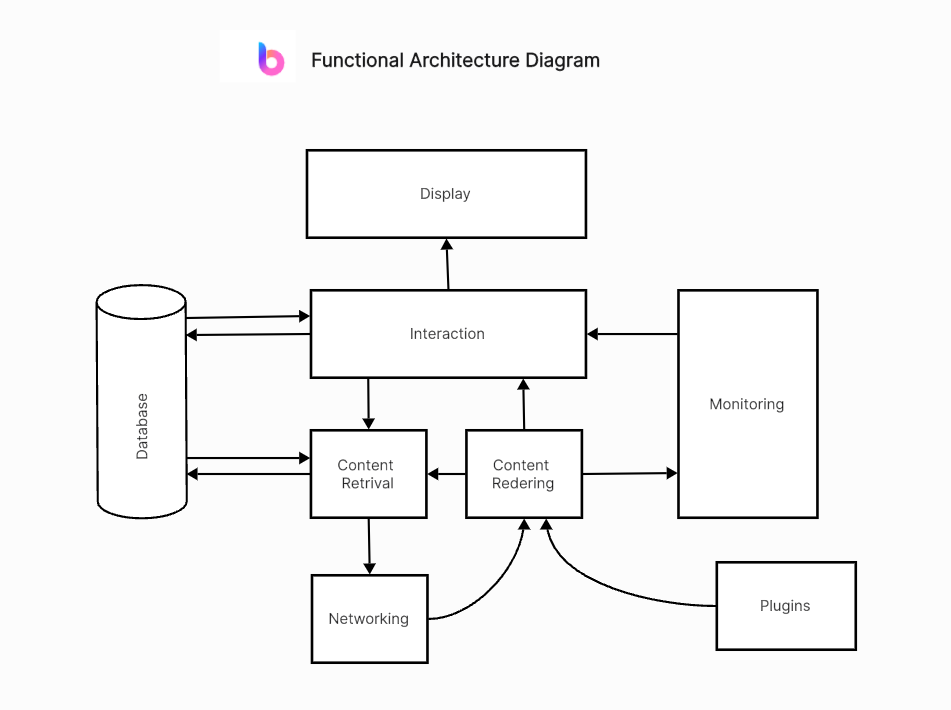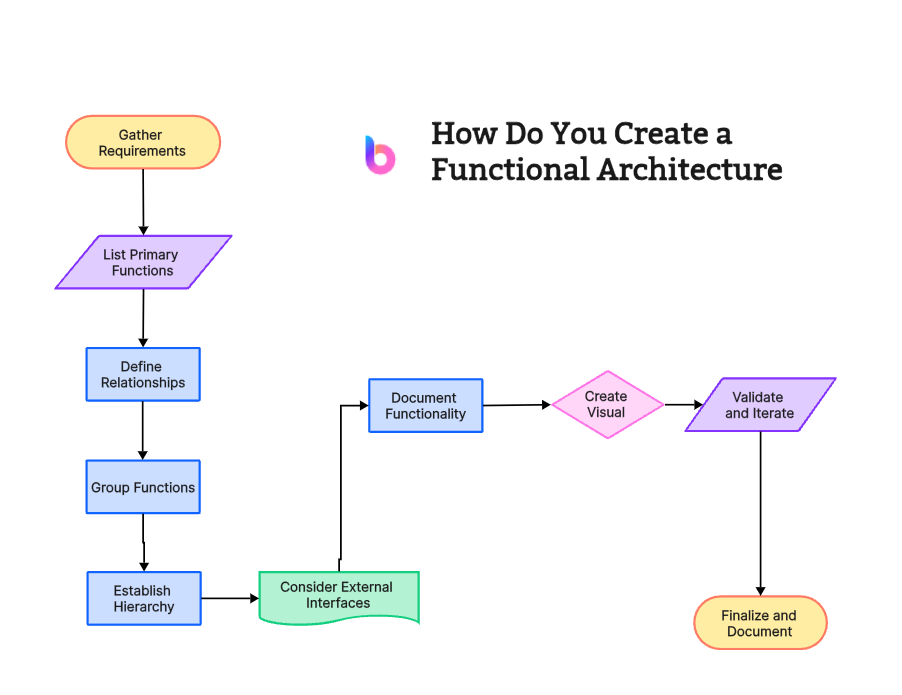Functional architecture diagrams play a crucial role in designing and understanding complex systems by illustrating the functions, components, and interactions within a system. These diagrams are instrumental in systems engineering, software development, and various other fields where a clear depiction of system functionality is essential. In this article, we will explore the key elements, benefits, and best practices associated with functional architecture diagrams.
Part 1. What is a Functional Architecture Diagram?
A functional architecture diagram provides a visual representation of a system's functional components and their interactions. It aims to capture the high-level functionality of a system without delving into the details of implementation. This type of diagram helps stakeholders, including architects, developers, and project managers, to gain a shared understanding of the system's structure and behavior.
Part 2. Key Components of Functional Architecture Diagrams
Functions: At the core of a functional architecture diagram are the functions performed by the system. These functions represent high-level tasks or operations that the system must execute to achieve its objectives.
Components: Functional architecture diagrams depict the major components or modules responsible for carrying out the system functions. Components can be physical entities such as hardware or software modules.
Interfaces: The interfaces between components illustrate how they interact and share information. Understanding these interfaces is crucial for ensuring smooth communication and data flow within the system.
Dependencies: Dependencies between functions and components are represented to highlight the relationships and the order in which various elements operate. This helps in identifying potential bottlenecks and critical paths within the system.
Part 3. Benefits of Functional Architecture Diagrams
Functional architecture diagrams play a crucial role in system design and development by visually representing the functional aspects of a system. Here are some benefits of using functional architecture diagrams:
Communication: Functional architecture diagrams serve as a common language for different stakeholders, fostering effective communication and collaboration among team members.
Understanding Complexity: Complex systems can be challenging to comprehend. Functional architecture diagrams simplify the understanding of intricate systems by breaking them down into manageable components and functions.
Decision-Making: Project managers and architects can make informed decisions based on a clear understanding of how different components interact and contribute to the overall functionality of the system.
Documentation: These diagrams serve as valuable documentation for future reference, aiding in system maintenance, updates, and troubleshooting.
Functional architecture diagrams offer a range of benefits throughout the development lifecycle, from initial planning and design to communication, documentation, and ongoing system maintenance.
Part 4. Best Practices for Creating Functional Architecture Diagrams
Creating effective functional architecture diagrams requires attention to detail and adherence to best practices to ensure clarity, accuracy, and usefulness. Here are some best practices for creating functional architecture diagrams:
Clarity and Simplicity: Keep the diagram clear and simple to ensure that it is easily understandable by all stakeholders, regardless of their technical expertise.
Consistency: Use consistent symbols and notation throughout the diagram to avoid confusion and misinterpretation.
Hierarchy: Hierarchically organize functions and components, showcasing the relationships between high-level and detailed system elements.
Annotations: Include relevant annotations to provide additional context or explanations for specific functions or components.
By following these best practices, you can create functional architecture diagrams that effectively communicate the design and functionality of a system to various stakeholders.
Part 5. How Do You Create a Functional Architecture?
Creating a functional architecture involves designing and organizing the various functions, components, and modules of a system to meet specified requirements. Here's a step-by-step guide on how to create a functional architecture:
- Gather Requirements: Understand the system's requirements by engaging with stakeholders and identifying key functionalities.
- List Primary Functions: Identify and list the primary functions that the system needs to perform based on the requirements.
- Define Relationships: Determine how functions interact and establish relationships, dependencies, and sequences between them.
- Group Functions: Group related functions together to create higher-level modules or components for organizational clarity.
- Establish Hierarchy: Define a hierarchy of functions to show their levels and relationships.
- Consider External Interfaces: Identify and specify external interfaces for communication with other systems, if applicable.
- Document Functionality: Document each function, outlining its purpose, inputs, outputs, and specific requirements.
- Create Visual Diagrams: Develop visual representations, such as block diagrams or flowcharts, to illustrate the functional architecture.
- Validate and Iterate: Validate the design with stakeholders, gather feedback, and iterate on the architecture as needed.
- Finalize and Document: Finalize the functional architecture, keep documentation updated, and ensure alignment with development capabilities.
By following these simplified steps, you can create a functional architecture that serves as a solid foundation for system development.
Part 6. Create Functional Architecture Diagrams with Boardmix
Boardmix is an innovative online whiteboard solution, engineered to transform how teams work together and bring their concepts to life visually. It provides an intuitive platform where users can create functional architecture diagrams with ease. With a vast array of drawing templates at your disposal, Boardmix allows you to map out complex systems, design workflows, and plan projects in a visually engaging manner. Whether you're a software engineer needing to outline system structures or a project manager looking to streamline processes, Boardmix's dynamic features cater to all your diagramming needs.
Some key features of Boardmix are:
- Extensive Template Library: Boardmix offers a wide range of pre-designed templates, making it easy for users to start creating diagrams without starting from scratch.
- Real-time Collaboration: With Boardmix, teams can work together on the same whiteboard simultaneously, fostering effective collaboration and idea sharing.
- Interactive Elements: Boardmix allows you to add interactive elements like sticky notes, shapes, and lines to your diagrams, enhancing the visual appeal and functionality of your designs.
- Easy Sharing & Exporting: You can easily share your Boardmix whiteboards with others or export them in various formats for further use or presentation.
- User-friendly Interface: The intuitive interface of Boardmix makes it easy even for beginners to create complex diagrams with ease.
- Scalability: Whether you're working on a small project or planning large-scale operations, Boardmix's features scale to meet your needs.
Conclusion
Functional architecture diagrams are powerful tools in the field of systems engineering and software development. By visually representing the high-level functions, components, and interactions within a system, these diagrams facilitate effective communication, decision-making, and documentation. Following best practices ensures that these diagrams are clear and concise, and serve their purpose in conveying the essence of complex systems. As technology continues to evolve, the importance of functional architecture diagrams in designing and understanding sophisticated systems is likely to persist and grow.
If you are looking for a diagramming tool to create a functional architecture diagram, then Boardmix is your best assistant. It has a variety of pre-designed templates and a powerful AI assistant. Get it for free now!








